CHAPTER 7
THE END OF ATOMISM?
The overriding tenet of atomism is that matter is made of tiny, indivisible particles: atoms. In the twentieth century, physicists realized that atoms have internal structure—that they are themselves made of smaller parts. The nucleus is made of protons and neutrons, which are themselves made of quarks. The scientists went on to discover a host of other subatomic particles, raising the question: what are the real atoms in the world? The truly fundamental, uncuttable parts of matter? What is the world really made of? The answer, it seems, is fields.

The tracks of thousands of particles produced by the high-energy collision of lead ions at CERN, near Geneva, Switzerland. Experiments like these have allowed physicists to probe matter at its most fundamental level and determine the interactions of the many kinds of particles with sizes or masses at or below the atomic scale.
THE SEARCH FOR THE ULTIMATE ATOMS
The original meaning of “atom” suggested that it should be “fundamental,” or “elementary”: an indivisible solid particle made of nothing else, with no inner structure. But modern physics has discovered that atoms, tiny though they are, are not nature’s ultimate building blocks. Instead, they are made of even smaller objects—and there exists a plethora of other tiny particles. Just as the periodic table finds order in the chemical elements, these particles are organized under a theory called the Standard Model.
The periodic table was an attempt to find order in the bewildering diversity of matter in the world around us. It was conceived before physicists knew of the existence of protons and neutrons, or even of electrons—but it turns out that the order in the table is a consequence of atomic structure based on the unintuitive but relatively simple rules of quantum mechanics. Each place in the periodic table is occupied by an element whose atoms have a certain number of protons and electrons, and the chemical properties of each element are determined by the way in which its electrons are organized around the nucleus. As such, physicists and chemists were not disappointed by the fact that atoms have an inner structure, because that inner structure helps to explain the patterns in the periodic table (see here). But the quest continued to find the true atoms—fundamental particles with no internal structure—continued.
MORE PARTICLES
After the discovery of the neutron, the picture of an atom as a nucleus made of protons and neutrons surrounded by a cloud of electrons persisted. To start with, atomic physicists could console themselves with the notion that while atoms were clearly not fundamental, at least protons, neutrons, and electrons were. And yet, through the twentieth century, a combination of theory and experiment uncovered a plethora of particles not previously dreamed of and eventually led scientists to realize that even protons and neutrons are not fundamental. They shook the neat idea of a world made simply of protons, neutrons, and electrons to its core.
First came British physicist Paul Dirac. In the late 1920s, Dirac found a way to combine quantum theory with relativity. He unwittingly discovered that the electron has a doppelgänger, or double, identical in everything except electric charge. The antielectron, or positron, has the same mass as the electron, but it carries a positively charge, instead of a negative one. The inescapable conclusion was that every particle has an associated particle (particles with no electric charge, such as the photon, are considered to be their own antiparticle). In the 1940s, Japanese physicist Hideki Yukawa (see here) postulated the existence of the pion, which was duly discovered in 1956. Meanwhile, photographs capturing the collisions of high-energy particles from space (cosmic rays) with atoms in our own atmosphere hinted at the existence of other types of particles. And with the rise of powerful particle colliders in the 1950s and 60s, particle physicists began to uncover a plethora of previously undiscovered particles. These particles were not part of an atom, and so did not make up ordinary matter as we know it—but what were they?
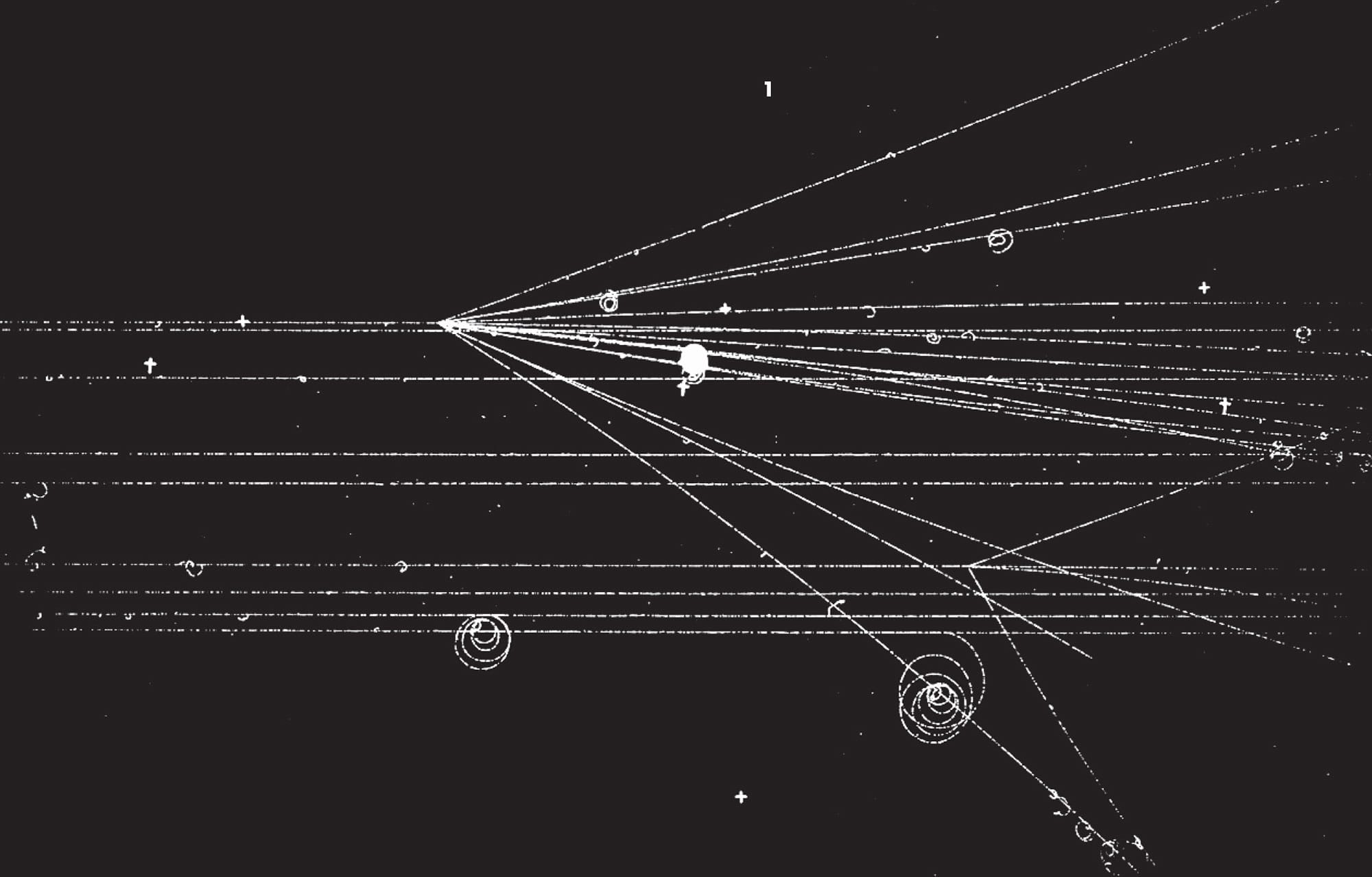
Photograph of a proton-proton collision (1) inside a bubble chamber at CERN (1960). The collision produced a shower of fourteen neutral particles (straight lines). Some protons knocked electrons from their orbits—the electrons spiraled in the chamber’s magnetic field.
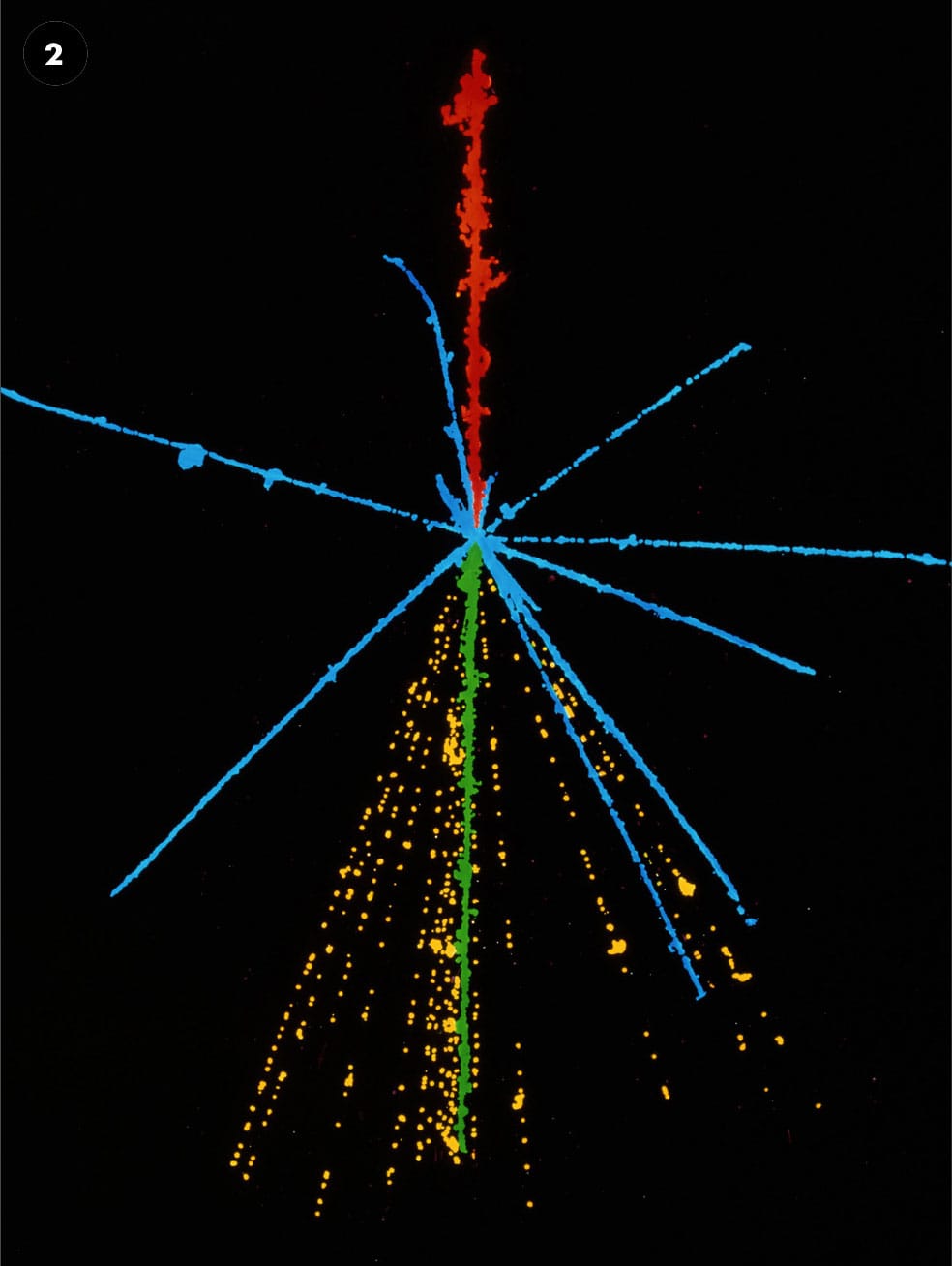
False color image (2) from an airborne photographic plate (1950) that recorded the collision of a cosmic ray particle (red) colliding with a nucleus in the photographic emulsion, producing pions (yellow), a fluorine nucleus (green), and other nuclear fragments (blue). (3) The first photograph (right) of a cosmic ray collision in a cloud chamber (1927). Note how charged particles bend in the magnetic field inside the chamber.
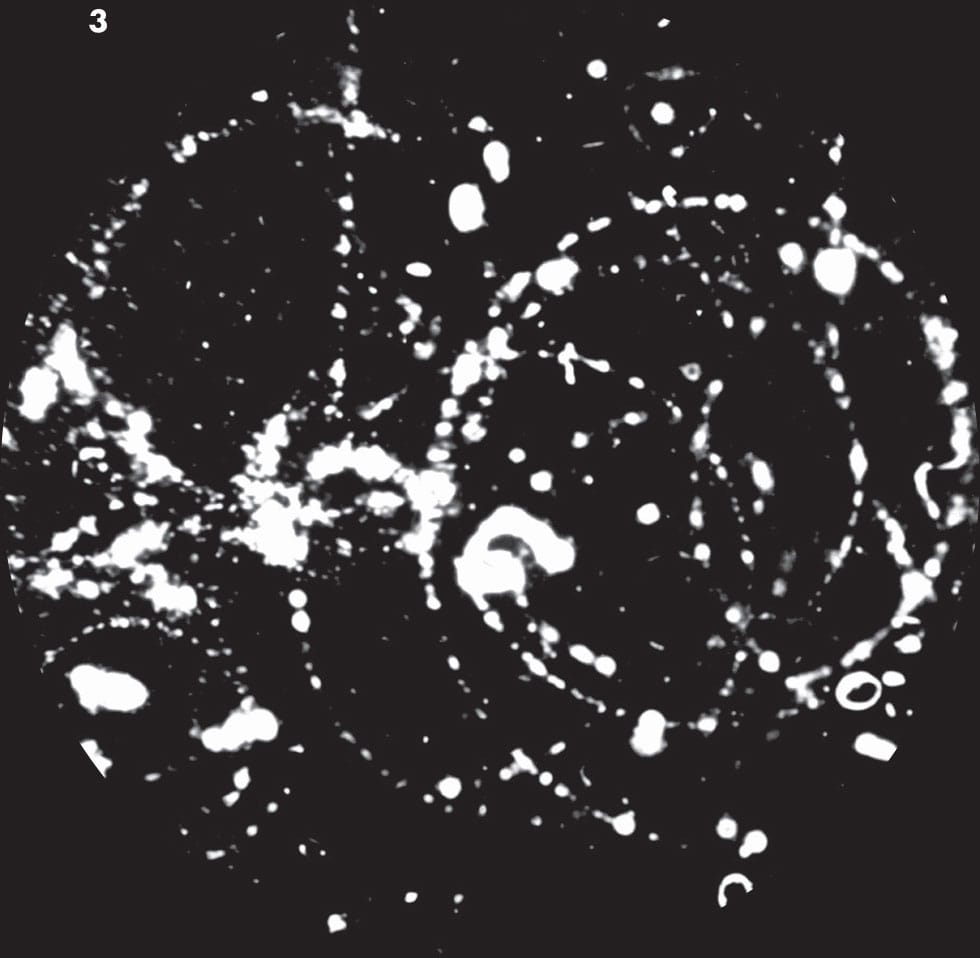
In 1952, American physicist Donald Glaser invented the bubble chamber, a tank of liquid (normally hydrogen) in which electrically-charged particles would leave tracks of tiny bubbles. Magnetic and electric fields inside the tank caused the particles to follow curved paths that depended upon the particles’ mass and charge. This device helped particle physicists to discover a slew of new particles that were produced by collisions between other particles in particle accelerators. Each particle had a different combination of charge and mass, and interacted with some particles but not others. Mysteriously, particles were also able to come mysteriously in and out of existence.
In the 1960s, American physicist Murray Gell-Mann and Russian-American physicist George Zweig tried to make sense of the many new particles by suggesting that many of them were composite—made of smaller particles that Gell-Mann named “quarks.” Their theory proposed that some particles were made of two quarks each, while protons and neutrons (and antiprotons and antineutrons) were made of three quarks each. The scientific community was dubious at first, but experiments in the 1970s proved the theory correct and confirmed the existence of quarks. Any particle consisting of quarks is a hadron, and any hadron made of two quarks is a meson, while any three-quark hadron is a baryon. At first, only two types of quark were considered: the “up” quark and the “down” quark (for example, a proton consists of two “up”s and one “down”). But it soon became clear that there must be others—equivalent quark pairs with higher masses, which were given the epithets “charm” and “strange,” and “top” and “bottom.” And, of course, each one has its antiparticle partner.

False color proton-proton collision (1) in a CERN bubble chamber. Charged particles follow spiral paths. In the false-color particle collision (2), the particle tracks are streams of tiny bubbles in neon and hydrogen mixture inside the bubble chamber at CERN. A gamma ray photon spontaneously creates an electron-positron pair (3). The new particles spiral away from each other, producing more photons that create more particle-antiparticle pairs. In a bubble chamber (4), a kaon (k-meson) collides with a hydrogen nucleus (proton) at the bottom of the image.
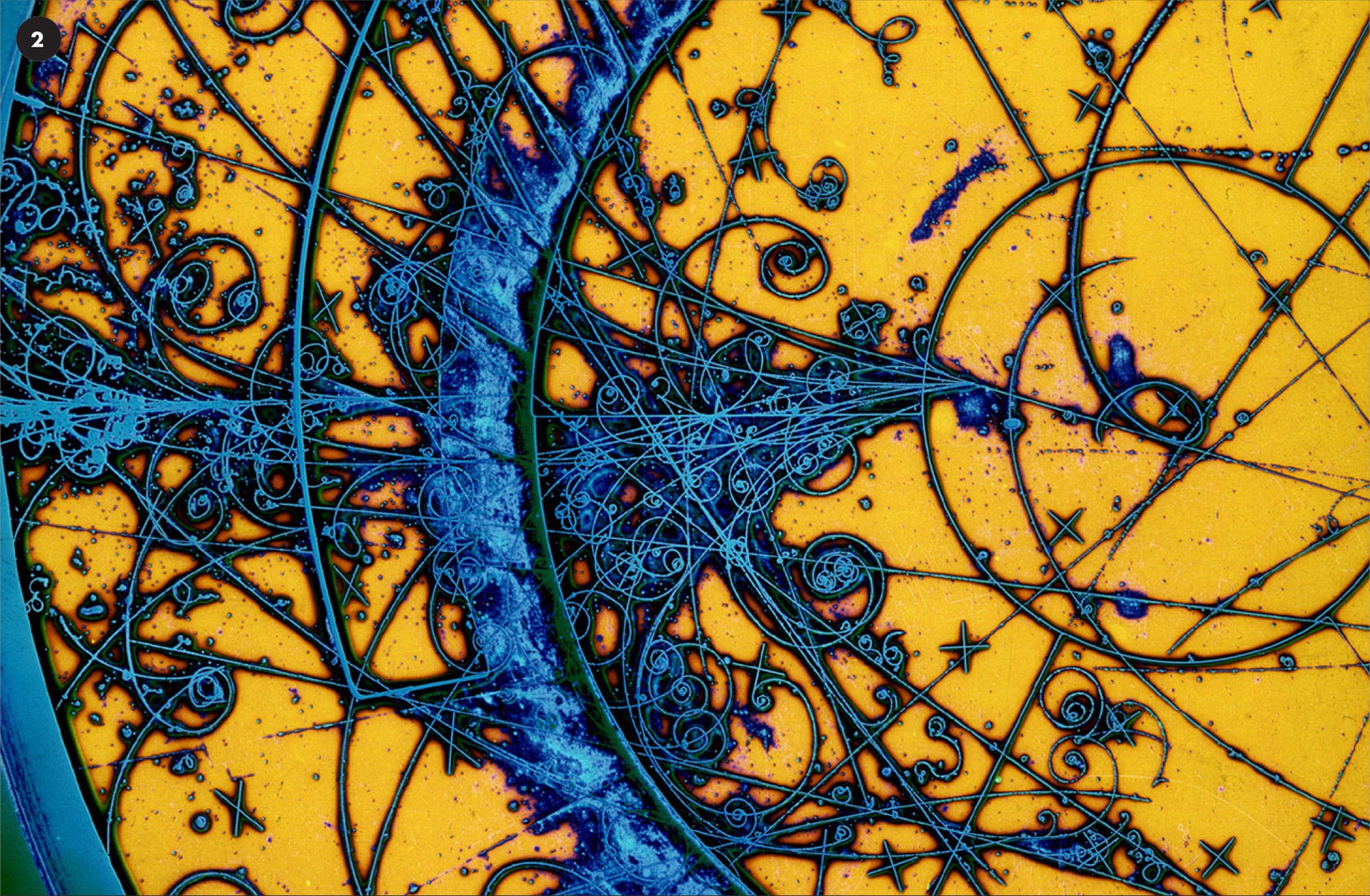
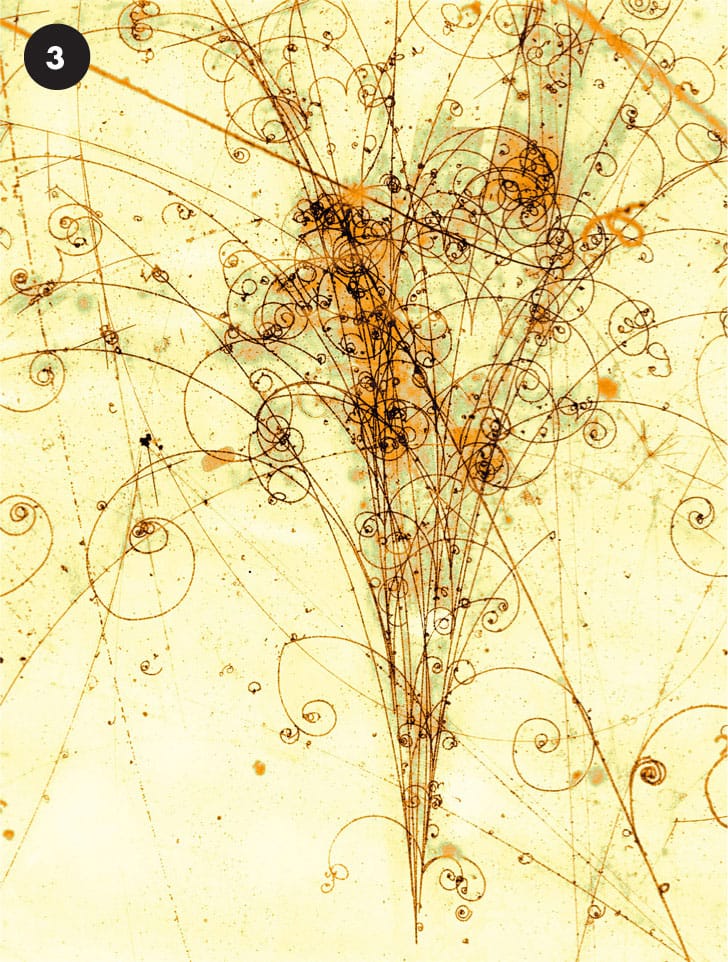

The electron remained stubbornly fundamental, and to this day seems not to have any internal structure. It does, however, have cousins, in the shape of the muon and the tao (and, again, their antiparticles, the antimuon and the antitau). These particles are alike in charge and general behavior, but they have more mass than the electron—and, unlike electrons, they are not constituents of ordinary matter. Yet another particle, the neutrino, is closely associated with the electron. Its existence was postulated in 1930 to help explain the mysterious loss of energy that occurs during beta decay (during which process a nucleus ejects an electron). The neutrino was discovered in the 1950s—and it, too, has more massive relations, the muon neutrino and tao neutrino. The electron, muon, and tao, plus their partner neutrinos—and each with an antiparticle—make up a family distinct from the hadrons, called the leptons.
By the 1970s, it seemed that matter was made of the (quark-based) hadrons plus the leptons. Alongside these particles were others that carried, or mediated, the forces between the particles of matter. These force-carrying particles are “gauge bosons”: the photon (which carries the electromagnetic force), the gluon (which carries the strong force between quarks), and the W and Z bosons (which carry the weak nuclear force involved in nuclear decay, more properly called the weak interaction).
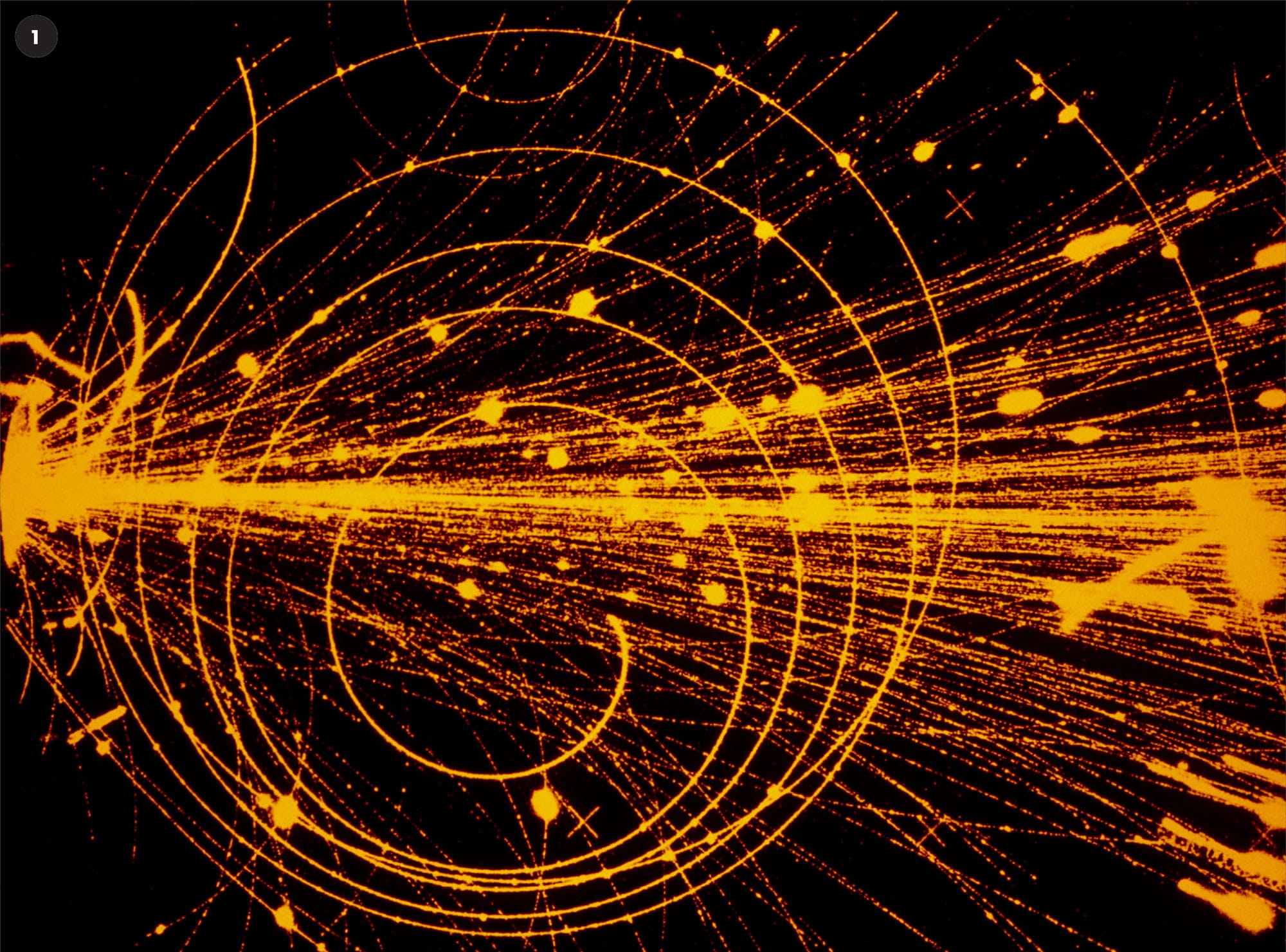
An oxygen ion collides with a lead nucleus at the left of the image (1), producing a shower of particles. The large spiral is the track left by a low-energy electron. (2) The decay of a positive kaon (K+) captured in a bubble chamber. The products of the decay speed and spiral away and some cause secondary collisions. (3) The discovery of “neutral currents,” one aspect of the weak interaction (1973). A neutrino, unseen, knocks an electron from its atom (seen bottom right). The electron shoots off to the left, creating electron-positron pairs.
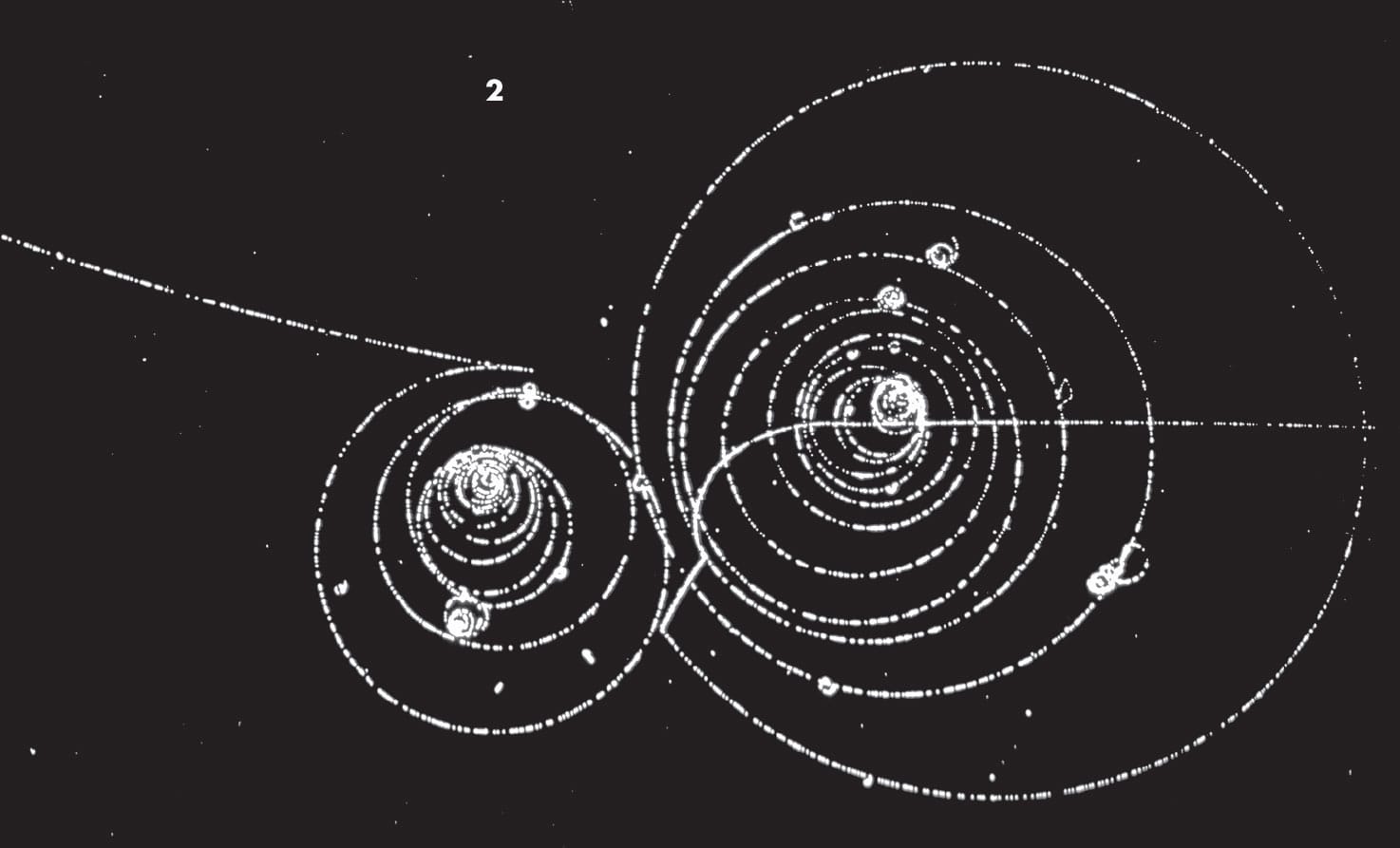
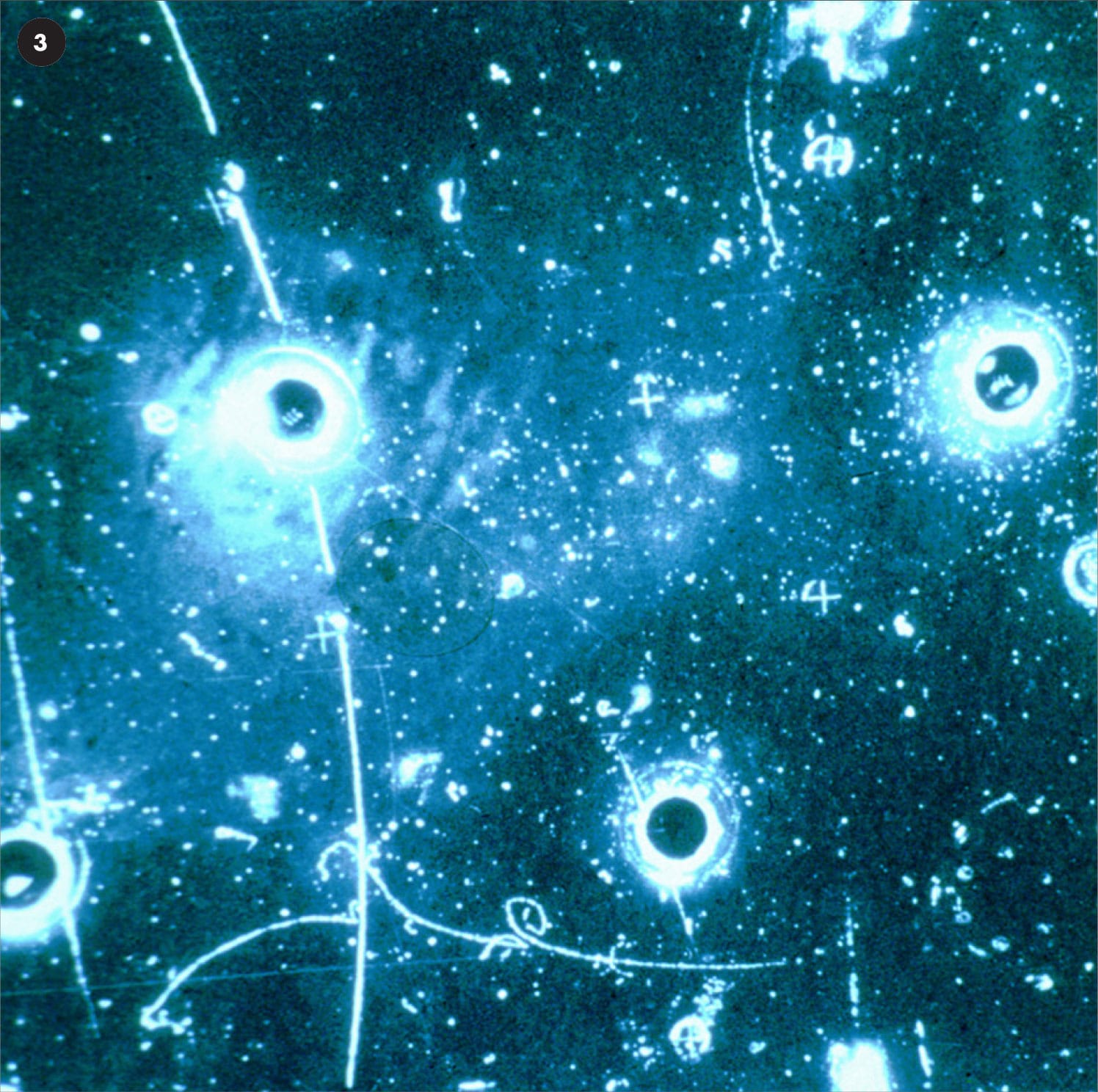
To make things more complicated still, there exists the quantum property called spin—something all elementary particles possess, and which makes charged particles into tiny magnets (see here). Some particles have half-integer spin (−3/2, −1/2, 1/2, 3/2, and so on); these are known as fermions, and only one fermion can exist in a particular quantum state. All leptons (including electrons) are fermions, as are all quarks. The force-carrying particles are bosons, particles with integer spin (−1, 0, 1, and so on). Any number of bosons can have exactly the same quantum state. Composite particles can be fermions or bosons, depending upon the total spin of the particles of which they are made. Some atoms, for example, can be bosons, and this is why it is possible for them to become Bose-Einstein condensates (many atoms occupying the same state, as a “superatom,” see here) at very low temperatures.
With so many different particles, and so many different ways of categorizing them, theoretical physicists sorely needed a way to make sense of what physicists began to refer to as the “particle zoo.” They needed something that could do for the world of elementary particles what the periodic table did for atoms and elements.

The tracks of a shower of particles (1) created by the collision of an extremely fast moving proton with a lead ion, at CERN in 2012. On the facing page is a screen grab (2) of the results of two proton-proton collisions in the CMS (Compact Muon Solenoid) detector in the Large Hadron Collider at CERN (2012). Below it (3) is a shower of spiraling charged particles produced after the collision of high-energy gold ions at the Relativistic Heavy Ion Collider at the Brookhaven National Laboratory, at Upton, New York.
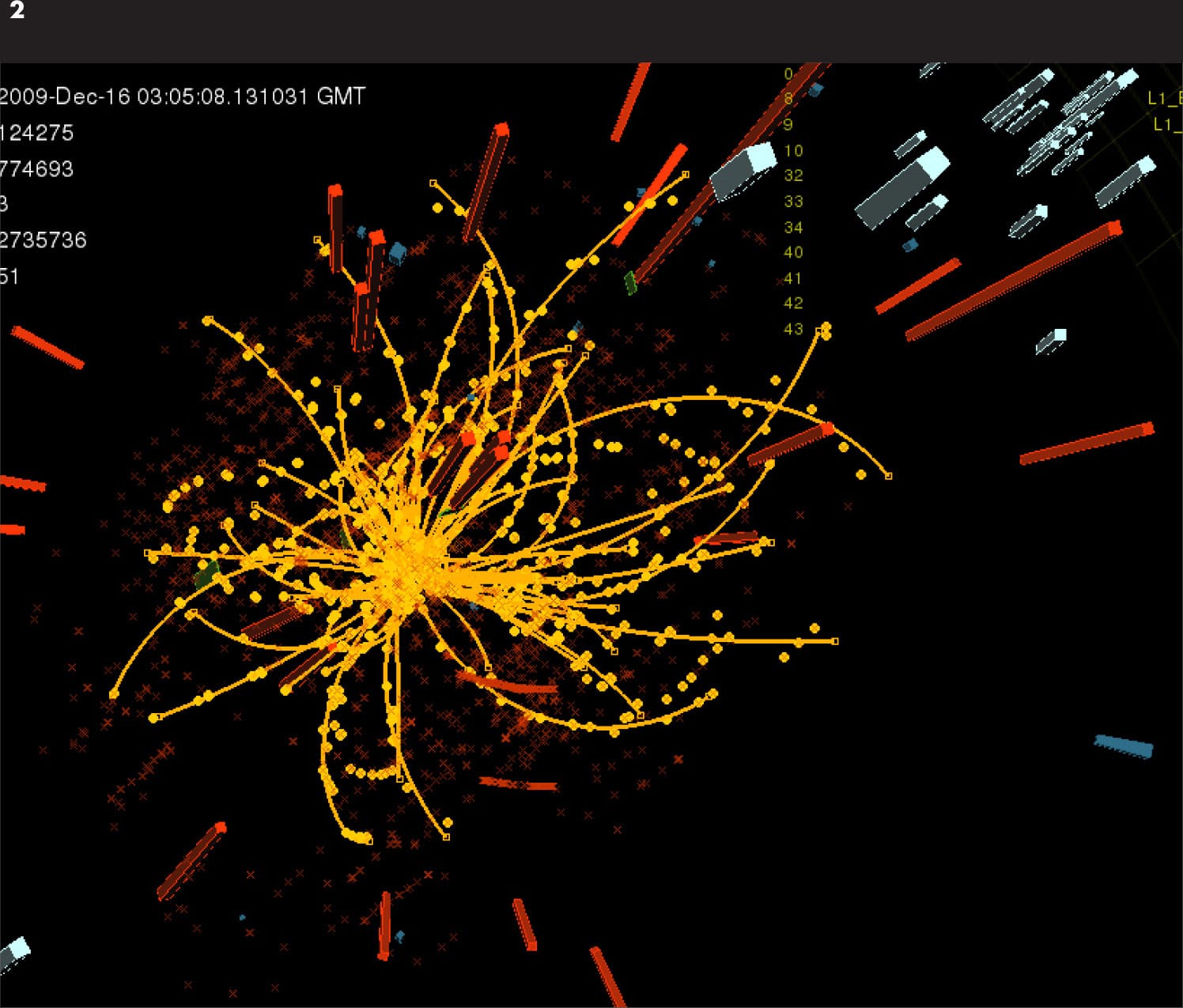
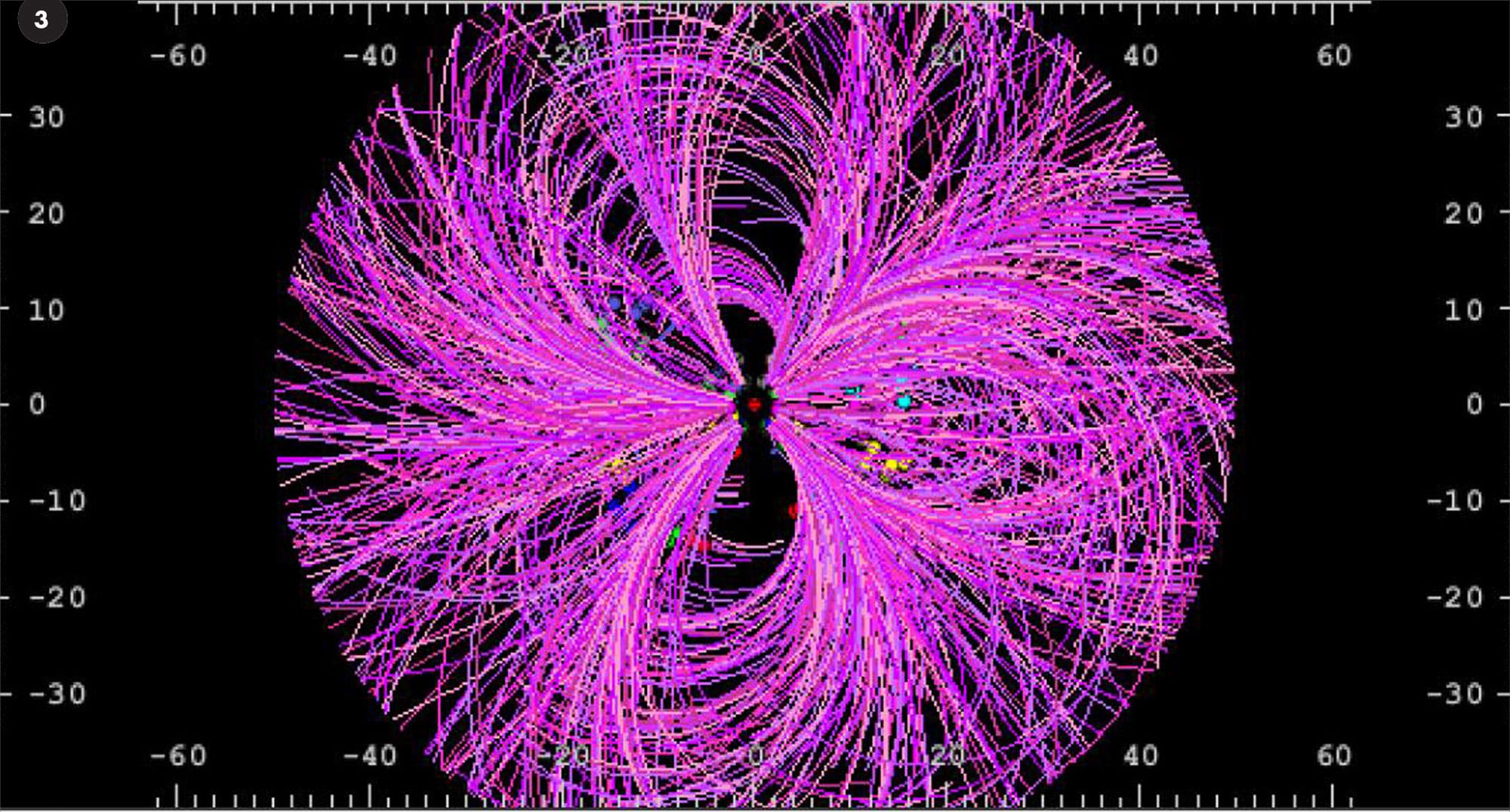
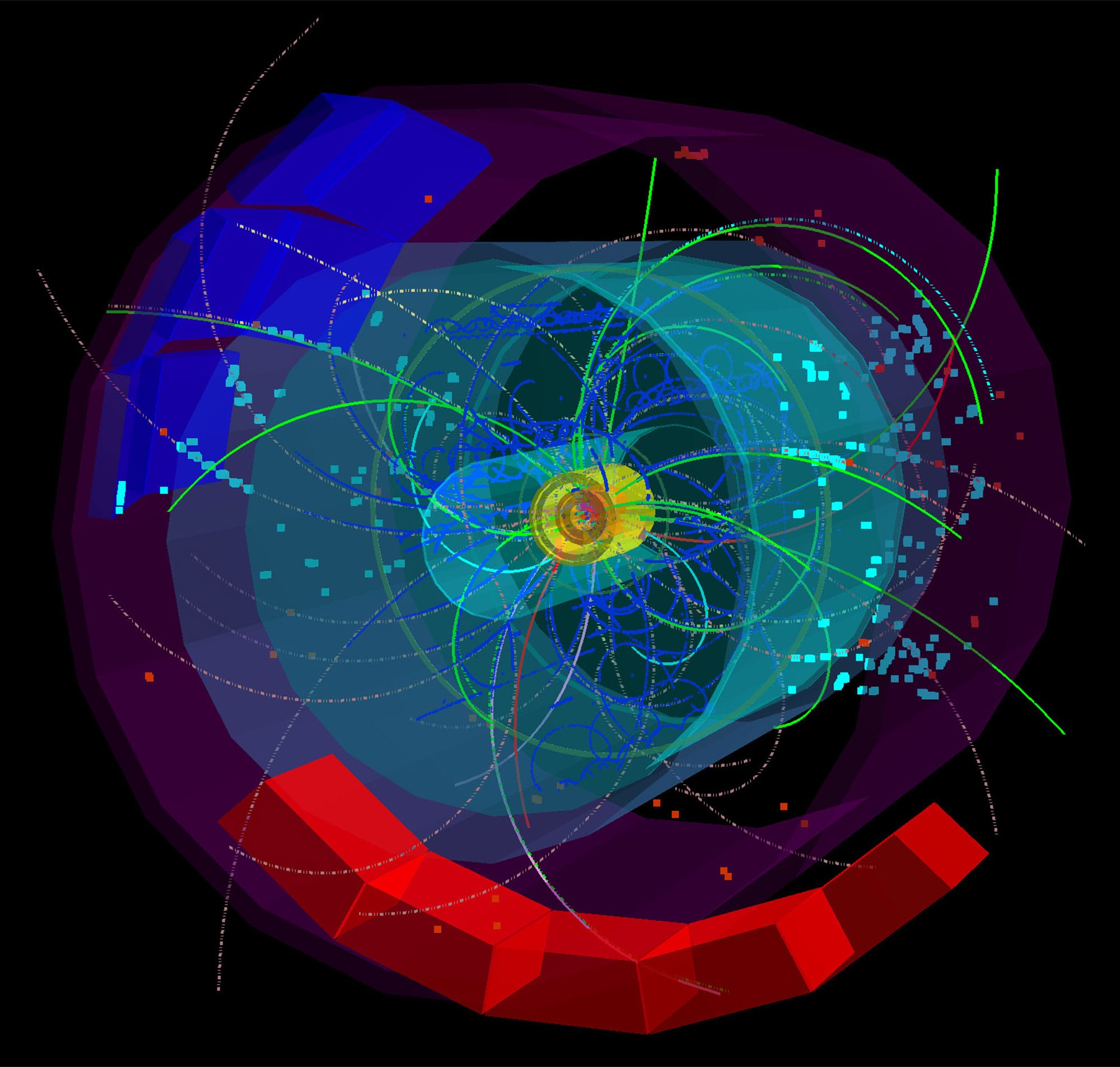
Computer reconstruction of a particle shower created by a collision of lead ions inside the ALICE detector at CERN.
STANDARD MODEL
The scientists were aware that various interactions of the matter particles (hadrons and leptons), and the force-carrying particles (the gauge bosons), seemed to follow patterns. There are in fact four kinds of such interactions: gravity, electromagnetism, the strong nuclear force, and the weak interaction. Gravity remains stubbornly different from the other three types of interaction. It is beautifully explained by Einstein’s theory of general relativity, and although there may still exist a particle that carries the force of gravity—the graviton—that particle has so far remained elusive. However, particle physicists have managed to codify the other three fundamental interactions. They have found order in what kinds of particle interact with what other, and how properties, such as charge and energy, must always be conserved in each interaction.
The result of this codification is an exquisite set of rules called the Standard Model, which can be summarized in a table showing the families of particles and how they interact. Order had been restored once again, and the members of the particle zoo tamed. The hundreds of particles that had been discovered can be accurately described using only twelve particles (six leptons and six quarks), plus four force-carrying particles (the gauge bosons).
There is an extra particle—another boson (but not a force-carrying gauge boson)—that was necessary to complete the Standard Model. This is the Higgs boson, and its celebrated discovery in 2012 in the Large Hadron Collider (LHC)—at the CERN research facility on the border between France and Switzerland—was the latest in a series of experimental results to support the efficacy of the Standard Model. Despite earning itself the epithet “the God particle,” the Higgs boson itself is not particularly important, but its production at CERN confirmed the existence of an entity called the Higgs field. The Higgs field helps to explain various key phenomena in the Standard Model, including the origin of the mass of fundamental particles. Fields such as the Higgs field are a fundamental underpinning of the Standard Model.
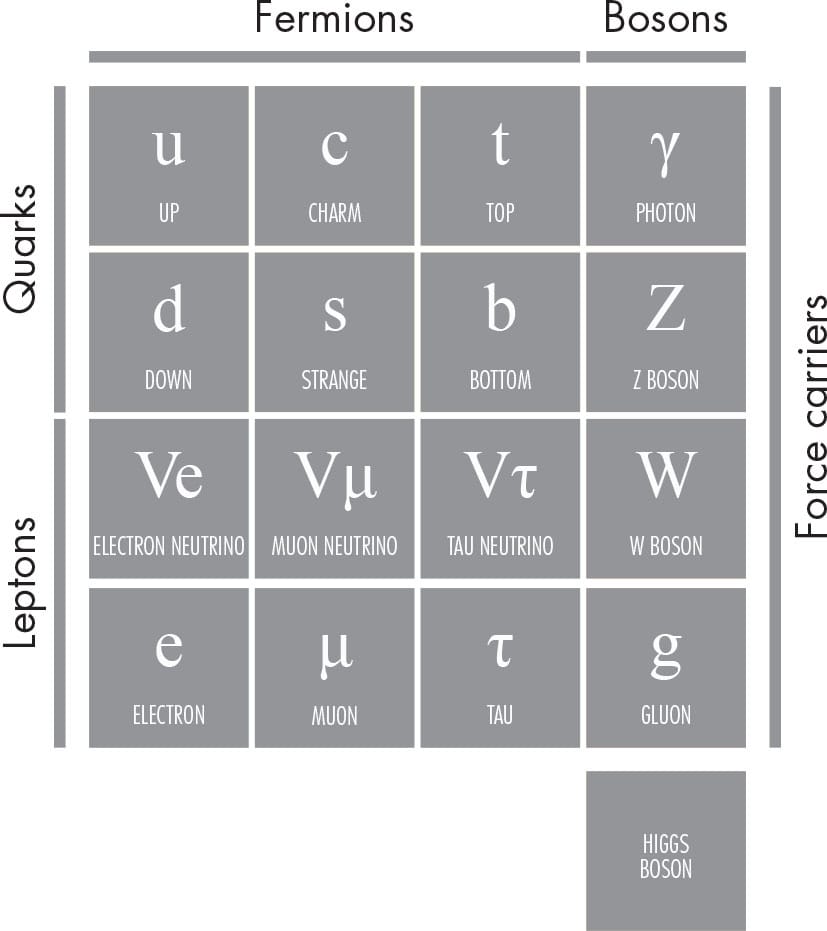
The fundamental particles of the Standard Model. Fundamental fermions are matter particles; fundamental bosons are force-carrying particles (except the Higgs boson). Source: AAAS
QUANTUM FIELDS
Underlying the Standard Model of particles and their interactions is the notion that particles are not solid objects; instead, they are disturbances in fields that permeate all of space. These fields are mathematical entities that help to describe such interactions, and they provide a crucial link between the wavelike and particle-like properties of what we normally think of as particles. In other words, they describe those particles in terms of quantum theory.
WHAT IS A FIELD?
The notion of fields dates back to the 1840s and was the brainchild of British scientist Michael Faraday. Throughout the 1820s and 30s, Faraday had been experimenting with electricity and magnetism. He realized that magnets and electric charges exert forces along definite lines that seem to permeate empty space. The strength of a field is different at different points in space; in other words, a magnet placed in a magnetic field will experience stronger or weaker forces at different locations within the field. In 1846, Faraday suggested that light might be a wave motion, a disturbance, within the electric and magnetic fields, an idea that James Clerk Maxwell confirmed mathematically twenty years later (see here). The fact that waves can propagate through fields is crucial—and became especially so when quantum theory exposed the wavelike nature of particles in the 1920s (see here).
The electric and magnetic fields exist as a single entity: the electromagnetic field. When physicists first applied quantum mechanics to understanding the atom, in the 1920s, they treated the energy states of the electron as quantized (only certain energies are allowed), but did not really consider how the electromagnetic field itself could be quantized. Several physicists later tried to address this shortcoming and formulated a theory in which photons are disturbances, or excited quantizations, of the electromagnetic field. The study of the interaction of the electromagnetic field with charged particles is called electrodynamics, and the emerging theory that addressed the quantization of the electromagnetic field became known as quantum electrodynamics (QED).
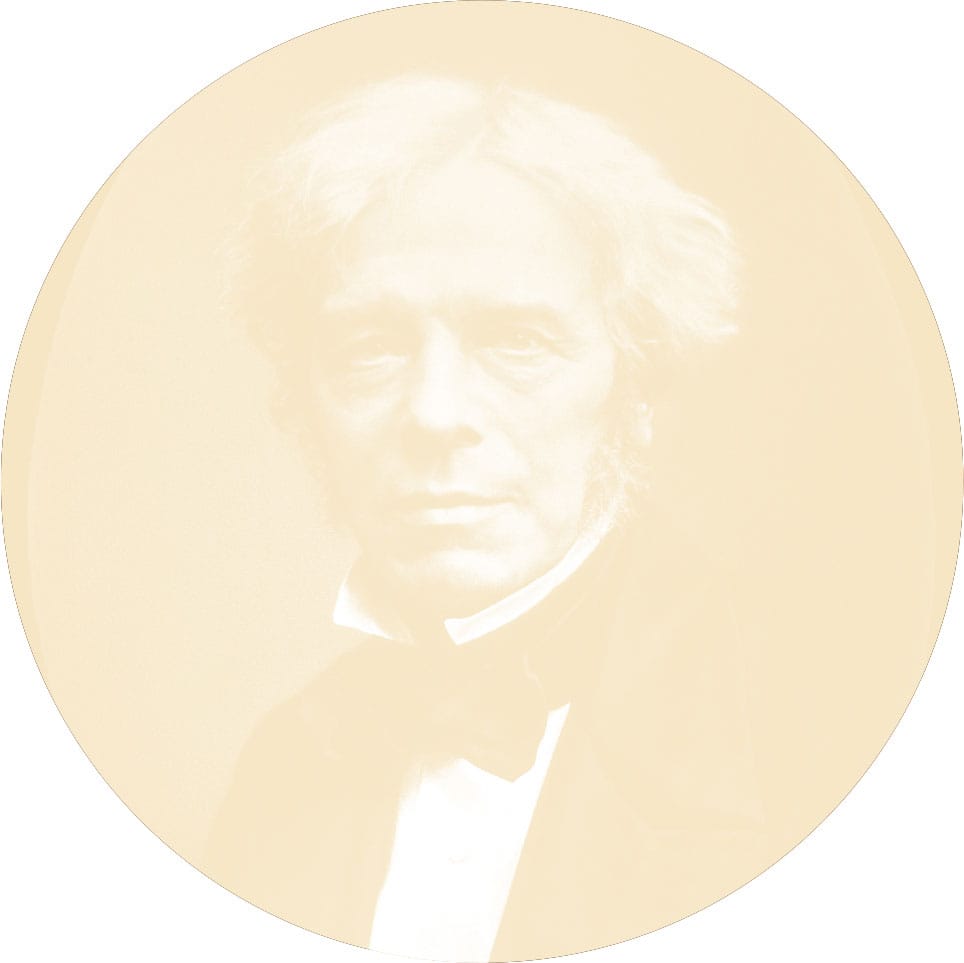
Michael Faraday, the scientist whose experiments contributed greatly to our understanding of electromagnetism. He used the word “field” for the first time in a diary entry dated November 7, 1845.
QUANTUM FIELD THEORY
The first theories to address the quantization of the electromagnetic field were made in the late 1920s. They were successful in describing and predicting the interaction between charged particles and photons mathematically. In QED, the photon is a disturbance, or “excitation,” that travels through the electromagnetic field, and physicists extended this notion to other interactions beyond electromagnetism. The interactions of particles affected by the strong nuclear force, for example, are described by quantum chromodynamics (QCD). The name derives from the fact that the quarks affected by the powerful nuclear force have a property similar to electric charge, called “color,” which determines how they interact. The force-carrying particles in the strong nuclear force are gluons—and in QCD, they exist as quantized excitations of a gluon field, just as photons are quantized excitations of the electromagnetic field. The weak interaction is described by a similar theory called quantum flavor dynamics (QFD—although the weak and electromagnetic interactions have been unified into a single field theory, the electroweak theory).
Quantum field theory (QFT) goes beyond just treating force-carrying particles (photon, gluon, and the W and Z) as excitations of fields. It also treats the particles of matter in the same way. In other words, the electron is actually a quantized excitation of an “electron field” that interacts directly with the electromagnetic field. This makes sense, because according to quantum theory and experiments, the electron behaves as a wave, too. So, according to QFT, there are twelve matter fields: one for each of the six leptons and one for each of the six quarks (each antiparticle is a manifestation of the same field as its particle partner). There are also the four force-carrying fields: one for each of the force-carrying particles (the gluon, the photon, and the W and Z bosons). Then there is the Higgs field—and there may be another, which describes the hypothetical graviton (proposed by some as the carrier of the gravitational interaction). These fields interact with each other, according to well worked-out mathematical rules. These describe not only the structure of matter we experience every day, but also all the many types of creation and annihilation events observed in particle accelerators.
Particle accelerators are a perfect testing ground for QFT. They supply energy that disturbs the fields; disrupt a field with enough energy, and you can create a particle. That was how the Higgs boson—among many other particles—was discovered. Similarly, when an electron loses energy, the electron field passes that energy to the electromagnetic field, and that is how a photon is made. The photons that carry the electromagnetic force (and the other force-carrying gauge bosons) can still affect matter particles without even coming into existence. In fact, most of the time they remain as potential, or “virtual,” particles, coming into and out of existence and staying around just long enough for their influence to be felt by the matter particles that they affect. Virtual particles can do this because of a facet of quantum theory called the uncertainty principle.

One frame of a computer-simulated animation shows the fluctuations of quark and gluon fields in empty space. The animation was produced using a supercomputer at the Centre for the Subatomic Structure of Matter and Department of Physics, University of Adelaide, Australia.
THE UNCERTAINTY PRINCIPLE
In chapter two, we explored two of the pillars of quantum physics—namely, the quantization of energy (and other properties), and wave-particle duality. There is a third: the uncertainty principle. According to the uncertainty principle, it is impossible to know both the exact position and momentum of a particle with complete accuracy (see box below). You can know the position well but have no idea of the momentum, and vice versa, or you can know both within a certain combined mutual limit. This restriction has nothing to do with the accuracy of any measuring apparatus; it is a fundamental law of nature.
The uncertainty relation between position and momentum makes these two properties of a particle “complementary variables.” There are other sets of complementary variables, including the energy involved in a process and the duration of that process. It is this fact that makes it entirely possible for a particle to come into existence from nothing, borrowing energy and returning it within a time specified by the uncertainty principle. And because it is possible, it happens. All the matter and force fields that permeate space are constantly seething with virtual particles, their fleeting existence creating a chaotic backdrop to the stage on which the “real” events of the universe take place. The uncertainty principle is also the reason why particles have energy even at absolute zero (see here)—and the reason why there is no such thing as truly empty space.
UNIFYING THE FIELDS
Electricity and magnetism were once considered separate forces, but they are now subsumed into a single theory of electromagnetism—and further into a unification with the weak interaction. Theoretical physicists hope to come up with a single theory that can explain all the various quantum fields and show how they are—or once were—part of a single field. In other words, it is possible that all the fields are different versions or manifestations of a single, unified field. In particular, the interactions between particles/fields seem to become unified at particularly high energies, such as those present in the first second of the universe’s existence. As the universe cooled, the interactions split into the four seemingly separate interactions that we observe today.
Whether there is a single, unifying quantum field or not, it seems that the only reality is fields. Particles are artifacts created by the excitation of those fields, but they exist within the fields, not separately from them. American physicist Freeman Dyson eloquently described the view of reality suggested by quantum field theory as long ago as 1953:
“The picture of the world that we have finally reached is the following. Some ten or twenty different quantum fields exist. Each fills the whole of space and has its own particular properties. There is nothing else except these fields: the whole of the material universe is built of them. Between various pairs of fields there are various kinds of interaction. Each field manifests itself as a type of elementary particle. The number of particles of a given type is not fixed, for particles are constantly being created or annihilated or transmuted into one another.”
A NEW PLENUM
The history of human ideas about what matter is made of has been increasingly dominated by atomism since the scientific revolution in the seventeenth and eighteenth centuries. And yet, in the last sixty years, it has become clear that everything we think of as a solid particle is just an excitation in a field that crosses all of space. The search for the ultimate building blocks of matter has taken us to the conclusion that there is no such thing.
LOOKING BACK
Atoms exist—but they are not the atoms envisaged by Democritus (see here). He imagined matter as made of tiny, indivisible balls moving around in empty space. And yet, there is no such thing as empty space; it is filled with fields and a seething, bubbling morass of virtual particles. The modern sense of the word “atom” refers to a composite particle in which electrons are held around a nucleus that is made, ultimately, of triplets of quarks. But even these particles—the electrons and the quarks—are not Democritus’s atoms; neither electrons nor quarks are solid balls. Every last one of the ten billion billion billion or so electrons in your body is an excitation of the electron field that fills all of space. Your body contains even more quarks than electrons—and they, too, are excitations of a field. If the quantum fields fill all of space, then everyone’s electrons are part of the same field. We are all part of reality’s complex, forever-shifting wave function.
Democritus’s idea was at odds with his contemporary, the Greek philosopher Parmenides of Elea (see here), who was adamant that there is no such thing as empty space, suggesting instead that every last corner of the universe is filled with a substance he called plenum. Nearly two and a half thousand years later, it seems that he was right. It may be hard to accept this picture of reality—comprising simply these ethereal fields existing everywhere—when the world seems to be so solid and weighty. But the solidity of a table and the weight of a bowling ball are both simply caused by interactions between the various fields. In principle, everything can be explained by these interactions.
Of course, no one knows what a field might be “made of.” Perhaps, because we can only describe them mathematically, reality is just made of numbers—as Pythagoras and his followers suggested more than two thousand years ago. Or perhaps they are made of some kind of fluidlike substance. After all, if particles travel through fields as quantized waves, then what is doing the waving? If a field really is a substance, then what might that substance be made of? Some kind of atoms, perhaps …?
Of course, no one knows what a field might be “made of.”